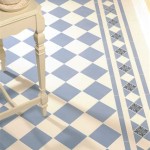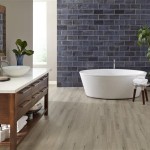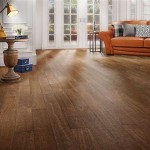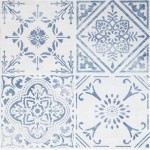Wood Peel and Stick Flooring: A Comprehensive Guide
Wood peel and stick flooring has emerged as a popular choice for homeowners and renters seeking an affordable and relatively easy-to-install flooring solution. This type of flooring offers the aesthetic appeal of hardwood or engineered wood flooring without the complexities and costs associated with traditional installation methods. It involves individual planks or tiles that have an adhesive backing, allowing them to be directly applied to a prepared subfloor. This guide provides a thorough examination of wood peel and stick flooring, covering its characteristics, benefits, installation process, maintenance requirements, and considerations for selecting the appropriate product.
Understanding the Composition and Construction
Wood peel and stick flooring typically consists of multiple layers designed to provide durability, stability, and visual appeal. The top layer, often referred to as the wear layer, is a protective coating that resists scratches, stains, and fading. This layer is crucial for determining the longevity and resilience of the flooring. The wear layer is commonly made of polyurethane or a similar durable material. Beneath the wear layer is the decorative layer, which features a printed image designed to mimic the appearance of natural wood. High-quality peel and stick flooring utilizes advanced printing techniques to create realistic wood grain patterns and textures. The core layer provides structural support and stability to the plank or tile, preventing warping or bending. This layer is often made of vinyl or a composite material. Finally, the adhesive backing is a pressure-sensitive adhesive that allows the flooring to adhere to the subfloor. The quality of the adhesive is critical for ensuring a strong and lasting bond.
The overall thickness of wood peel and stick flooring can vary depending on the manufacturer and product line. Thicker flooring generally offers greater durability and sound insulation, but it may also be more expensive. The wear layer thickness is a particularly important factor to consider, as it directly impacts the flooring's resistance to wear and tear. For high-traffic areas, a thicker wear layer is recommended. When evaluating different products, it is essential to carefully examine the specifications provided by the manufacturer to determine the composition and construction of the flooring.
Advantages of Wood Peel and Stick Flooring
Wood peel and stick flooring offers several distinct advantages over traditional flooring options. The primary advantage is the ease of installation. The peel and stick design eliminates the need for specialized tools, adhesives, or professional installers, making it a suitable option for DIY enthusiasts. This can significantly reduce the overall cost of the flooring project. Furthermore, the installation process is typically faster and less disruptive than traditional flooring installations.
Another advantage is the affordability of wood peel and stick flooring. It is generally less expensive than hardwood, engineered wood, or laminate flooring, making it an attractive option for budget-conscious homeowners. The reduced labor costs associated with DIY installation further contribute to the overall cost savings. Despite its affordability, wood peel and stick flooring can still provide a visually appealing and aesthetically pleasing result.
Wood peel and stick flooring is also relatively easy to maintain. It is typically water-resistant, making it suitable for kitchens, bathrooms, and other areas prone to moisture. Regular cleaning with a damp mop and mild detergent is usually sufficient to maintain the flooring's appearance. However, it is important to note that while water-resistant, it is not entirely waterproof and should not be subjected to prolonged exposure to standing water. Additionally, the flooring is available in a wide variety of styles, colors, and patterns, allowing homeowners to customize their flooring to match their décor.
The ease of replacement is another benefit. If a plank or tile becomes damaged, it can be easily removed and replaced without affecting the surrounding flooring. This is a significant advantage over traditional flooring options, where repairs can be more complex and expensive.
Installation Process: A Step-by-Step Guide
Proper preparation is essential for a successful installation of wood peel and stick flooring. The first step is to ensure that the subfloor is clean, level, and dry. Any debris, dust, or existing flooring remnants should be removed. If the subfloor is uneven, it may be necessary to apply a leveling compound to create a smooth surface. This is crucial for ensuring that the peel and stick flooring adheres properly and lays flat.
Once the subfloor is prepared, it is recommended to acclimate the flooring to the room's temperature for at least 48 hours before installation. This allows the flooring to expand or contract, preventing issues with buckling or gaps after installation. The planks or tiles should be laid out in the room to determine the best layout and minimize waste. It is advisable to start the installation along a straight wall, leaving a small expansion gap around the perimeter of the room. This gap allows for natural expansion and contraction of the flooring due to changes in temperature and humidity.
The peel and stick flooring is installed by peeling off the backing paper and carefully positioning the plank or tile on the subfloor. It is important to apply firm pressure to ensure that the adhesive bonds securely. A rolling pin or floor roller can be used to further enhance the adhesion. Subsequent planks or tiles should be aligned tightly against the previously installed ones, ensuring that there are no gaps or overlaps. A utility knife can be used to cut the flooring to fit around obstacles or along walls. It is recommended to use a straight edge to guide the knife and ensure a clean, accurate cut.
After the installation is complete, it is advisable to avoid heavy traffic on the flooring for at least 24 hours to allow the adhesive to fully cure. Furniture should be carefully placed on the flooring, and protective pads should be used under the legs of heavy items to prevent scratches or dents. Regular sweeping or vacuuming is recommended to remove dirt and debris. Spills should be cleaned up promptly to prevent staining or damage to the flooring.
Considerations for Selecting Wood Peel and Stick Flooring
Selecting the appropriate wood peel and stick flooring requires careful consideration of several factors. The first factor is the intended use of the flooring. For high-traffic areas, such as hallways or living rooms, a thicker wear layer is recommended to ensure durability and longevity. For areas with high moisture levels, such as bathrooms or kitchens, it is important to choose a water-resistant product. It is also important to consider the subfloor material. Some peel and stick flooring products are not compatible with certain subfloor types, such as concrete or existing vinyl flooring. It is crucial to consult the manufacturer's recommendations to ensure compatibility.
The aesthetic appeal of the flooring is another important consideration. Wood peel and stick flooring is available in a wide range of styles, colors, and patterns, allowing homeowners to choose a product that complements their décor. It is important to consider the overall design scheme of the room and select a flooring style that enhances the aesthetic appeal. Samples of the flooring should be obtained and evaluated in the actual room to ensure that the color and pattern are a good match.
The quality of the adhesive is a critical factor to consider. A high-quality adhesive will ensure a strong and lasting bond between the flooring and the subfloor. It is important to read reviews and research the manufacturer's reputation to ensure that the adhesive is reliable. Some peel and stick flooring products have a history of adhesive failure, resulting in planks or tiles lifting or shifting over time. These products should be avoided. The price of the flooring is also a factor to consider. While wood peel and stick flooring is generally less expensive than traditional flooring options, the price can still vary depending on the quality, style, and brand. It is important to compare prices from different retailers and manufacturers to find the best value for the money.
Finally, the warranty offered by the manufacturer should be carefully reviewed. A comprehensive warranty can provide peace of mind and protect against defects in materials or workmanship. The warranty should cover issues such as adhesive failure, fading, and wear. It is important to understand the terms and conditions of the warranty before making a purchase.
Maintenance and Care Tips
Proper maintenance and care are essential for extending the life of wood peel and stick flooring. Regular cleaning is crucial for removing dirt, dust, and debris that can scratch or damage the surface. A broom, vacuum cleaner, or damp mop can be used for routine cleaning. It is important to use a mild detergent specifically designed for vinyl flooring. Harsh chemicals or abrasive cleaners should be avoided, as they can damage the wear layer and dull the appearance of the flooring.
Spills should be cleaned up promptly to prevent staining or water damage. A soft cloth or sponge should be used to blot the spill, avoiding rubbing or scrubbing. For stubborn stains, a solution of water and vinegar can be used. It is important to test the solution on an inconspicuous area first to ensure that it does not damage the flooring.
Protective mats or rugs should be placed in high-traffic areas, such as entryways and hallways, to prevent dirt and debris from being tracked onto the flooring. Furniture legs should be equipped with protective pads to prevent scratches or dents. Heavy objects should be moved carefully to avoid damaging the flooring. Direct sunlight can cause fading or discoloration of the flooring over time. Window coverings, such as curtains or blinds, should be used to protect the flooring from excessive sunlight.
Periodically, the flooring may need to be deep cleaned to remove built-up dirt and grime. A floor cleaning machine or a specialized vinyl floor cleaner can be used for this purpose. It is important to follow the manufacturer's instructions carefully when using these products. Wax-based polishes should be avoided, as they can leave a residue that is difficult to remove. With proper maintenance and care, wood peel and stick flooring can maintain its appearance and durability for many years.

7 Things To Know Before Trying Peel And Stick Flooring

5 15pcs Wooden Floor Peel And Stick Tiles Coverings Reinforced Thickened For Waterproofing Bat

Lacheery 36 X6 Brown Peel And Stick Floor Tile Wood Look Waterproof Vinyl Plank Flooring Tiles On Bathroom Stickers Self Adhesive Temporary For Renters Removable 4 Pieces Walmart Com

Art3d Old Wood 12mil 36in L X 6in W Waterproof Peel And Stick Vinyl Flooring 54sq Ft Box A43hd204

Lacheery 6 X36 Peel And Stick Vinyl Plank Flooring Light Brown Wood Floor Tiles Waterproof Look Removable Bathroom

Art3d Old Wood 6 In X 36 Water Resistant Peel Stick Vinyl Floor Tile Easy Diy Self Adhesive Flooring 54 Sq Ft Case A43hd009 The Home

Peel And Stick Vinyl Flooring All Things To Know Before Buying Lx Hausys

Dc Fix Grey Wood Peel And Stick Vinyl Floor Tiles 30 48cm X Create Your World

How To Install Peel And Stick Vinyl Plank Flooring Floor Preparation

Self Adhesive Wood Effect Floor Planks Grey Homesavers








